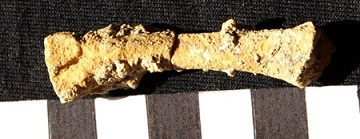By Howie G. Severino, GMANews.TV
Move over, Tabon Man. Callao Man is here.

A team of archaeologists led by Dr. Armand Mijares of the University of the Philippines-Diliman has confirmed that a foot bone they discovered in Callao Cave in Cagayan province was at least 67,000 years old. Tabon Man’s remains were a relatively young 50,000 years old.
The foot bone discovered in Callao Cave was a mere 61 millimeters or 2.4 inches. Photo courtesy of Dr. Armand Mijares.
“So far this could be the earliest human fossil found in the Asia-Pacific region. The presence of humans in Luzon shows these early humans already possessed knowledge of seacraft-making in this early period,” Mijares told GMANews.TV in an exclusive interview conducted by email in between archaeological digs.